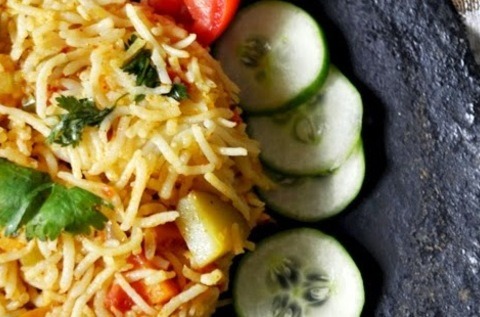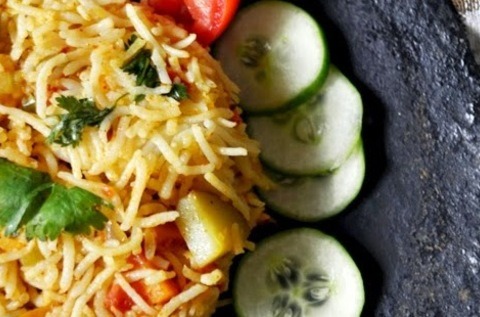#Tawa Pulao
Text
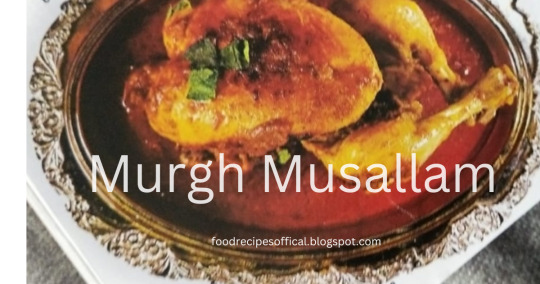
Murgh Musallam
We teach you in Food Recipes. Recipes for making Murgh Musallam. One of the royal dishes of the Mughals, the taste of Murgh Musallam is very good. If you are a non-veg lover, then you must taste the taste of Murgh Musallam. Murgh Musallam is a Mughlai dish originating from the Indian subcontinent. It consists of whole chicken marinated in ginger-garlic paste, stuffed with boiled eggs and cooked with spices like saffron, cinnamon, cloves, poppy seeds, cardamom and chillies. Murgh Musallam is served on a platter In which gravy is poured over the chicken. It is advisable to garnish the dish with chopped almonds and serve rice with it. Read more
#Garlic Spinach#Veggie Puffs#Mix Veg#Roasted Potato#Malai Pyaaz#Tawa Pulao#Paneer Tikka#Cheese stick snacks#Bharwan Tamatar#Poha#Paneer butter masala#Thandai Phirni#Fenugreek Muthia#Rasgulla#Spicy Chane#Masala Kaju Mushroom#yogurt dipChilli paneer#Cutlets basically#Benduvada-Sambhar#Potato Eggplant#Fried Idli Part -2#poha#lunch
3 notes
·
View notes
Photo
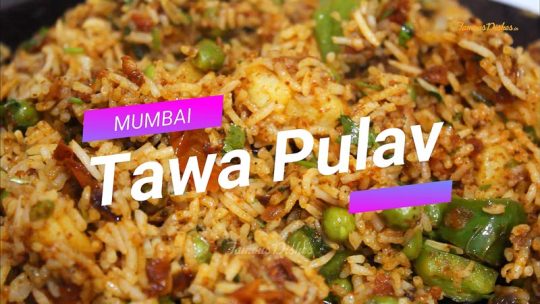
We have shared a step by step tutorial on how to cook #Tawa #Pulao. Watch the video and follow along. This #recipe is very easy to make and tastes #delicious too! It's one of our favorite recipes for family gatherings and parties.
Checkout Our Detail Recipe Blog ➡️ https://famousdishes.in/tawa-pulao-recipe-how-to-make-tawa-pulao-at-home/
Checkout recipe video ➡️ https://youtu.be/sS4ggZv1Ojw
0 notes
Text
Pav bhaji pulao - veggie dum biryani in instant pot using pav bhaji masala
Pav Bhaji Pulao or an easy veggie dum biryani with pav bhaji masala.. made in instant pot.I have always been a very strong believer of reusing and repurposing food, ingredients and dishes.This is one such recipe, make a yummy veggie loaded pav bhaji masala for breakfast and the repurpose the masala with this famous street dish called tawa biryani. But it is not a tawa biryani now, I have made it…

View On WordPress
#Biriyani#instant pot dum biryani#pav bhaji masala biryani#pav bhaji pulao#tawa biryani#veggie dum biryani
0 notes
Photo
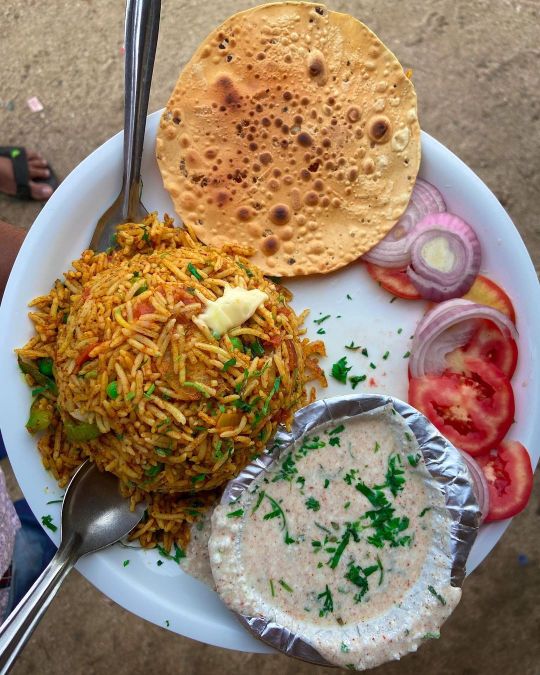
I really like this Tawa Pulao from the beach side stalls of Juhu Beach 😍😍😍 How many of you tried this ⁉️⁉️⁉️ Tag your Mumbai Wala Friends in the comments section 😁😁😁 . . . #food #tawapulao #juhubeachmumbai #mumbaifood #vegitarianfood #deliciousfood (at Juhu Beach, Mumbai) https://www.instagram.com/p/CnpKDPvvxEh/?igshid=NGJjMDIxMWI=
2 notes
·
View notes
Video
youtube
How to Make Restaurant-Style Masala Tawa Pulao #tawapulaorecipe #recipe ...
0 notes
Link
tawa pulao recipe | mumbai tawa pulao | pav bhaji pulao with step by step photo and video recipe. pulao or pilaf recipe is one of the staple food in india prepared for lunch, dinner and for tiffin boxes. having said that, there are many local and street style versions too, which is typically consumed as a snack. mumbai tava pulao is one such easy and quick and easy pulav recipe made with leftover pav bhaji gravy recipe.
1 note
·
View note
Text

In Food Recipes, we teach you how to make Veg Poha Balls. Poha Balls are a dish served in Narate. After coming from school, there is a desire to eat something different and they are looking for snacks. In such a situation, you can give the children the fun of 'Veg Poha Bowls' as a snack, which gives excellent taste. So let's know Maharashtra, And in Gujarat, people like to eat poha in the morning breakfast. Rice poha is its main ingredient. People like to eat poha bowls by adding peanuts and potatoes. Poha balls keep you energized. Poha is the first choice of every person. Antioxidants are found in poha bowls. Poha balls are rich in proteins. Read nure
#Garlic Spinach#Veggie Puffs#Mix Veg#Roasted Potato#Malai Pyaaz#Tawa Pulao#Paneer Tikka#Cheese stick snacks#Bharwan Tamatar#Poha#Paneer butter masala#Thandai Phirni#Fenugreek Muthia#Chilli paneer#lunch#malai pyaaz#paneer tikka
3 notes
·
View notes
Text
Exploring the Rich Flavors of India at SpiceVillage.eu - Your Premier Indian Grocery Store
India, a land renowned for its diverse and vibrant cuisine, offers a culinary experience like no other. From fragrant spices to exotic ingredients, Indian cuisine has captivated taste buds worldwide. If you're on a quest to bring the authentic flavors of India to your kitchen, look no further than SpiceVillage.eu, your premier online Indian grocery store. In this article, we will take you on a journey through the treasure trove of flavors offered by SpiceVillage.eu, making your culinary adventures more exciting and delicious.
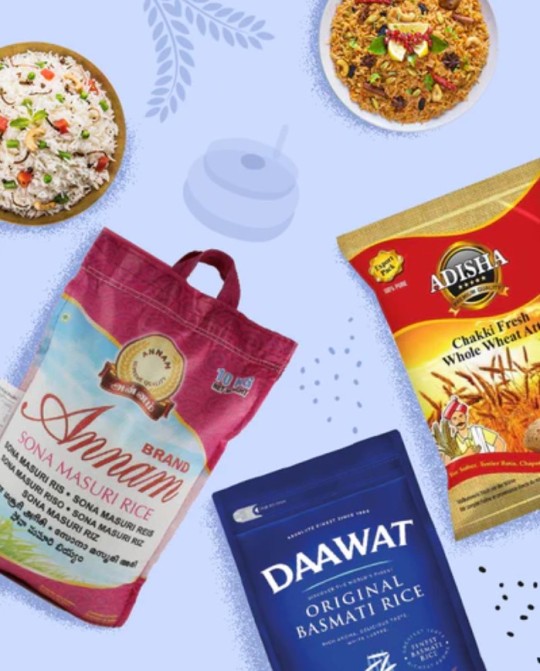
A World of Spices:
Spices are the heart and soul of Indian cuisine, and SpiceVillage.eu is your gateway to a world of aromatic and flavorful spices. From the fiery heat of red chili powder to the earthy depth of cumin seeds, you'll find an extensive range of spices that cater to all taste preferences. Whether you're a novice or a seasoned chef, these spices will elevate your dishes to new heights.
Rice and Grains Galore:
Rice is a staple in Indian cooking and SpiceVillage.eu offers an array of rice varieties to choose from. Basmati rice, renowned for its fragrant aroma and delicate texture, is a must-have for biryanis and pulao. Additionally, you'll find a selection of lentils, dals, and grains like quinoa and bulgur, allowing you to diversify your menu with healthy and nutritious options.
Authentic Indian Flours:
Indian Grocery Store Berlin provides a range of flours, including whole wheat atta and besan (gram flour), essential for creating traditional Indian flatbreads like chapati and puri. These flours are also versatile ingredients in many other dishes, both savory and sweet.
Culinary Convenience:
In addition to raw ingredients, SpiceVillage.eu offers a variety of ready-made Indian mixes and spice blends. These convenient products make it easy to prepare authentic Indian dishes at home. From curry powders to garam masala blends, you can trust SpiceVillage.eu to provide high-quality, pre-mixed spices that simplify your cooking process.

Delightful Snacks and Sweets:
Indian Grocery Store Near Me range of delectable namkeens, chivda, and crunchy papads that are perfect for snacking. For those with a sweet tooth, indulge in mouthwatering Indian sweets like gulab jamun, rasgulla, and jalebi, all available at SpiceVillage.eu.
Cookware and Kitchen Essentials:
SpiceVillage.eu goes beyond groceries by offering an assortment of cookware and kitchen essentials. Find the right tools, pots, and pans to prepare your Indian delicacies with precision and authenticity. From traditional tandoors to non-stick dosa tawas, you'll discover everything you need to master Indian cooking techniques.
A Commitment to Quality:
At SpiceVillage.eu, quality is paramount. Every product is sourced with care to ensure that you receive the freshest and most authentic ingredients. Whether it's whole spices, grains, or ready-to-cook mixes, you can trust that SpiceVillage.eu maintains the highest standards in quality and freshness.
Convenience at Your Fingertips:
Shopping at SpiceVillage.eu is a hassle-free experience. Their user-friendly website allows you to browse, select, and purchase your favorite Indian groceries with ease. With secure payment options and prompt delivery services, SpiceVillage.eu brings the flavors of India directly to your doorstep.
Conclusion:
If you're an aspiring home chef or an Indian food enthusiast, SpiceVillage.eu is your one-stop destination for all things Indian cuisine. With a wide range of spices, grains, flour, snacks, and cookware, you have everything you need to embark on a culinary journey through the rich and diverse flavors of India. Visit SpiceVillage.eu today, and let your kitchen become a canvas for creating authentic and delicious Indian dishes that will delight your family and friends.
Blog Source URL :
#indian grocery online free shipping#online groceries online berlin#spice village#indian grocery in germany#india shop berlin
0 notes
Text
Tawa Paneer Recipe
Paneer dry curry is a delicious dish made on a pan with pav bhaji spices. It is generally one of the most common streets that people eat before or after a meal. Paneer Tawa Masala is a spicy dish that can be made in minutes and is very easy to make.
Many Indians enjoy paneer recipes. Onion and tomato gravy is usually used to make paneer curry or curry. However, there is also a unique dry paneer curry known as Tawa Paneer Recipe, which is served with roti and naan on the street in India.
As mentioned earlier, this unique paneer tawa masala recipe can be made dry or with gravy. Tawa Paneer Pav Bhaji is made with spices unlike other curries. Because of this, many types of flavors are mixed together in it. Street vendors selling chaat and other dishes created the recipe by mistake. Pav bhaji tawa is used to prepare this curry, which mainly contains cheese, leftover pav bhaji gravy and capsicum. This recipe is like another tawa pulao recipe, in which the rice is made with additional pav bhaji masala. This recipe is unique in that it can be served with roti, chapati and other things. It can be served as an appetizer or starter with rice of your choice.
As mentioned earlier, this unique Tawa Paneer Recipe can be made dry or with gravy. Tawa Paneer Pav Bhaji is made with spices unlike other curries. This is the reason why combinations of many flavors are tracked in it. Street vendors selling chaat and other dishes created the recipe by mistake. Pav bhaji tawa is used to prepare this curry, which mainly contains cheese, leftover pav bhaji gravy and capsicum. Similar to another tawa pulao recipe, this one uses leftover pav bhaji masala to make rice. One specialty of this recipe is that it can also be served with roti or chapati etc. It can be served as an appetizer or starter with rice of your choice.
For more information visit the link: https://cookingkhajana.in/tawa-paneer-recipe/
0 notes
Text
Tawa Pulao Recipe
Long rice and pav bhaji masala are the two main ingredients in this famous spicy street style pulao recipe. This is a commonly important quick pulao recipe in India which originated from the nearby Mumbai streets. It is spicy and hence served with curd raita, but it is also delicious without raita.
In India, pulao or pilaf is one of the most common dishes for lunch, dinner and tiffin boxes. Having said that, there are many street style and local variations of it that are commonly eaten as a snack. Mumbai tawa pulao recipe is one such simple, quick and easy recipe of pav bhaji made with the gravy from the previous batch.
I've shared a ton of rice recipes that follow the traditional pulao style or traditional-style rice recipes. However, this pulao is completely unique and made using a quick and simple street style recipe. Basically, this recipe involves adding cooked rice and roughly chopped vegetables to leftover pav bhaji gravy. Similarly, it is made in a large pav bhaji tawa, in which this spicy and delicious rice dish gets ready in a jiffy. Nevertheless, in this recipe post, I have explained the best way to make a simple desi tawa pulao recipe with just pav bhaji masala in a major pan without the need of pav bhaji sauce. It's quick to prepare and doesn't require any kind of hardware like you'd find in road merchants.
Furthermore, while making Mumbai Tawa Pulao recipe, I would like to draw attention to some essential, straightforward guidelines. First of all, before making Tawa Pulao recipe, cool the rice completely. Otherwise, the rice becomes soft and resembles porridge in texture. Alternatively, leftover rice can be used to speed up the process. Additionally, other vegetables can also be added to make it more nutritious. Finally, I added some chili powder for added heat; You can leave it if you want. Or on the other hand you can keep it as per your choice.
For more information visit the link: https://cookingkhajana.in/tawa-pulao-recipe/
0 notes
Text

DELICIOUS TAWA PULAO
Website - https://rajwadigauravrestaurant.com/
Call Us On- 9578604604
#pulao #foodie #rice #tawapulao #pulaorice
#foodporn #singaporefoodie #sgeats #instafood
#foodie #sgfoodporn #foodsg #sgfoodlov
#foodphotography #sgfoodblogger #sgfoodtrend
#sgig #singaporeinsiders #sgfooddiary #foodporn #love
#loveforindia #indiancurries #curryculture #vegetarianfood
#vegetarian #feast #rajwadi #rajwadigaurav
#best restaurant in hinjewadi#best restaurant in pimple saudagar#best restaurant in wakad#rajasthani thali in wakad#thali restaurant in wakad#banquet hall in wakad
0 notes
Text
The Timeless Elegance of Brass Cookware: The Benefits, Care, and Cooking Tips You Need to Know | Zishta.com
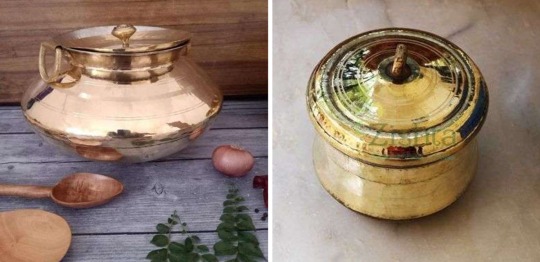
What is Brass Cookware?
Brass cookware is cookware made of brass, a metal alloy composed of copper and zinc. Brass cookware is known for its ability to conduct heat evenly and quickly, making it a popular choice for cooking.
Brass cookware is typically lined with another metal called tin, to prevent acidic foods from reacting with the brass. Brass cookware can be used for a variety of cooking methods, including frying, sautéing, and braising.
Brass cookware is also prized for its durability and aesthetic appeal, as it can add a touch of elegance to any kitchen.
Traditional History of Brass Cookware in India
Brass cookware has a long history in India and has been used for centuries in traditional cooking. Brass vessels have been found in archaeological excavations dating back to the Indus Valley civilization, which flourished in the Indian subcontinent from around 2600 BCE to 1900 BCE.
In Indian culture, brass utensils are considered auspicious and are often used during special occasions and religious ceremonies. Brass cookware is also popular in Ayurvedic cooking, as it is believed that cooking in brass vessels can enhance the health benefits of certain foods and spices.
In many regions of India, brass utensils are handcrafted by skilled artisans using traditional techniques passed down through generations. These artisans use a combination of hammering, shaping, and carving to create intricate designs on the brass cookware.
Today, brass cookware is still widely used in Indian kitchens and is particularly popular for making traditional dishes such as biryani, halwa, and kadhi. However, due to the increased availability of other types of cookware, such as stainless steel and non-stick cookware, brass cookware has become less common in modern Indian households.
Traditional Clusters Making Brass Cookware
There are several regions in India known for their traditional brass cookware artisans, each with their unique styles and techniques. Here are a few examples:
Jandialaguru, Punjab: Jandiala Guru is a town in the Tarn Taran district of Punjab, India, which has a long history of brass crafts and is known for its skilled brass artisans. The brass makers of Jandiala Guru specialize in creating traditional brass cookware, as well as other decorative and utilitarian brass items.
Jaipur, Rajasthan: Known for its rich cultural heritage, Jaipur is also a hub for the traditional brass craft. Here, artisans create intricate brass cookware with detailed engravings and designs.
Kerala: The southern state of Kerala is known for its brass utensils, particularly the uruli, a shallow brass vessel used for cooking and serving. Artisans in Kerala use traditional techniques like sand casting and hand hammering to create unique brass cookware as well.
Tamil Nadu: In the town of Kumbakonam in Tamil Nadu, skilled brass artisans create a range of cookware including tawas, pans, and vessels for boiling milk. These artisans use techniques like sheet metal forming and brazing to create their brass cookware.
Moradabad, Uttar Pradesh: This city in northern India is famous for its brass industry, and is home to many skilled artisans who create a wide range of brass cookware, from plates and bowls to larger vessels like handis and degchis.
These are just a few examples, as many regions throughout India have a rich history of brass craft and cookware production.
What can be cooked in brass cookware?
Brass cookware can be used to cook a wide variety of dishes, including:
Rice dishes: Brass handis and degchis are commonly used in Indian cuisine to cook rice dishes such as biryani and pulao. The even heat distribution of brass cookware helps to ensure that the rice cooks evenly and doesn't burn.
Curries: Brassware is also ideal for making curries and stews, as the brass helps to retain heat and distribute it evenly. This makes it easier to cook dishes for longer periods, allowing the flavours to develop and the meat or vegetables to become tender.
Sweets: Brass cookware is also commonly used to make sweets such as halwa and laddoos, as the even heat distribution of the brass helps to prevent burning and ensure that the sweets cook evenly.
Deep-fried foods: Brass kadai or brass fry pan, and Jalebi trays are often used to deep fry foods like pakoras, samosas, and other Indian snacks. The high sides of the kadai help to prevent oil splatters, while the brass material conducts heat efficiently for crispy and evenly fried food.
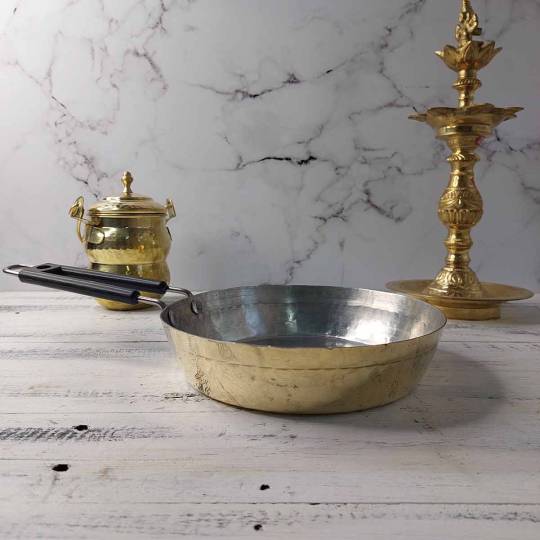
It's worth noting that brass is reactive to acidic ingredients like tomatoes, tamarind, or vinegar, which may cause a metallic taste and discolouration of the cookware. Therefore, it's best to use brass cookware for less acidic dishes or with a protective lining with tin.
What is Kalai (Tinning)? How frequently do we have to do Kalai for Brass Cookware?
youtube
Kalai or tinning is a process of coating brass cookware with a layer of tin, which helps to protect the brass from corrosion and also prevents the food from reacting with the brass. The frequency of kalai or tinning required for brass cookware depends on how frequently it is used and how well it is maintained.
In general, if you use your brass cookware frequently, it's a good idea to get it kalai or tinned every 1-2 years. If the cookware is not used as often, it may not need to be kalai or tinned as frequently.
Regular cleaning and maintenance can help to extend the life of your brass cookware and delay the need for kalai or tinning. After each use, make sure to clean the cookware thoroughly with warm water and mild detergent, then dry it completely to prevent any moisture from building up and causing corrosion.
If you notice any signs of corrosion or discolouration on your brass cookware, it's a good idea to get it kalai or tinned as soon as possible to prevent further damage.
What are the precautions to be taken while cooking with Brass Cookware?
Brass cookware has been used in Indian cooking for centuries, and it can be a great addition to any kitchen. However, some precautions should be taken when cooking with brass to ensure that it is safe and effective.
Avoid using brass cookware for acidic foods if it has no Kalai (Tin Coating): Brass is reactive to acidic ingredients like tomatoes, tamarind, and vinegar, which can cause a metallic taste and discolouration of the cookware. Therefore, it's best to avoid using brass cookware for dishes that are high in acidity.
Don't use harsh cleaning agents: Harsh or abrasive cleaning agents can damage the surface of the brass and make it more susceptible to corrosion. Instead, use a soft cloth or sponge to clean the cookware.
Avoid overheating brass cookware: Brass cookware can be prone to hot spots, which can cause the food to burn or stick. It's important to avoid overheating the cookware and to stir the food regularly to ensure that it cooks evenly.
Use utensils made of wood or silicone: Metal utensils can scratch the surface of the brass and cause it to corrode more quickly. It's best to use utensils made of wood or silicone to avoid damaging the cookware.
By following these precautions, you can help to ensure that your brass cookware is safe, effective, and long-lasting.
How to Maintain Brass Cookware?
Maintaining brass cookware is important to ensure that it lasts for a long time and remains safe to use. Here are some tips for maintaining brass cookware:
Clean the cookware after each use: After each use, clean the brass cookware with warm water and mild detergent. Use a soft cloth or sponge to avoid scratching the surface. Rinse thoroughly and dry completely to prevent moisture from building up.
Avoid using harsh cleaners or abrasive materials: Avoid using harsh or abrasive cleaning agents, as they can damage the surface of the brass and cause it to corrode more quickly. Instead, use mild detergents and soft cleaning materials.
Polish the cookware regularly: Brass cookware can become tarnished over time. To restore its shine, polish the cookware regularly with a mixture of equal parts lemon juice and baking soda. Apply the mixture to the surface of the cookware with a soft cloth, then rinse thoroughly and dry completely.
Store the cookware properly: Store the brass cookware in a dry place away from moisture to prevent corrosion. You can also wrap it in a soft cloth or paper to protect it from dust and scratches.
Get it re-tinned: Over time, the tin coating on brass cookware can wear off, exposing the brass to the acids in food. If you notice that the tin coating is wearing off, get the cookware re-tinned by a professional.
By following these tips, you can help to ensure that your brass cookware remains in good condition for many years to come.
Do Brass Cookware work on Induction Cooktops?
No, brass cookware does not work on induction cooktops. Induction cooktops work by using an electromagnetic field to heat a ferromagnetic metal, such as cast iron or stainless steel. Brass is not ferromagnetic and therefore will not work on an induction cooktop.
However, induction-compatible cookware sets feature a layer of ferromagnetic material on the bottom of the cookware, allowing it to work on induction cooktops. Some manufacturers also offer induction-compatible brass cookware, but these products may be harder to find and more expensive than traditional brass cookware.
If you are looking to use brass cookware, it's important to note that it is best suited for gas stoves, Glass top/electric coil hobs or open-flame cooking. Brass cookware heats up quickly and evenly, making it ideal for traditional Indian cooking methods.
Can we store cooked food in brass with kalai for a long duration?
It is not recommended due to the following reasons:
Sometimes if the kalai had worn off, the brass could start reacting with the acidic elements of the food cooked in them causing discolouration.
When we store for a long and if the food type seems to dry out, then they will stick to the tin coating and you would have to scrub and remove the same. This can cause the tin coating to wear off faster.
It is for these reasons we do not recommend you store cooked food in brass cookware for a very long duration. Storing it for up to 2 -3 hours or lesser is ideal.
What are the Benefits of cooking in brass?
Cooking in brass has been a traditional method of cooking in India for centuries. Here are some potential benefits of cooking in brass:
Even heat distribution: Brass is a good conductor of heat and distributes heat evenly, which can result in better cooking outcomes.
Preservation of nutrients: The heat generated by brass cookware is relatively gentle, which can help to preserve the nutrients in food, especially in vegetables.
Natural anti-microbial properties: Brass has natural anti-microbial properties that can help to inhibit the growth of harmful bacteria and germs in the food.
Low maintenance: Brass cookware is relatively easy to maintain and does not require frequent seasoning or special cleaning other than tinning.
Aesthetic appeal: Brass cookware has an attractive and elegant appearance that can enhance the overall look of the kitchen and the dining table.
Durable: Brass Cookware is durable and if well maintained, can be passed on to generations.
It's important to note that there are also some precautions and limitations when using brass cookware, as mentioned earlier. However, many people continue to use and enjoy cooking in brass due to its traditional and cultural significance, as well as its potential benefits.
What are the Disadvantages of Brass cookware?
While there are many potential benefits of cooking in brass, there are also some disadvantages to using brass cookware. Here are a few to consider:
Reactive metal: Brass is a reactive metal and can react with acidic or salty foods, which can cause the food to become discoloured and develop a metallic taste.
Requires maintenance: Brass cookware requires regular maintenance, including polishing and re-tinning with kalai, to prevent tarnishing, corrosion, and potential health hazards.
Not suitable for all cooktops: Brass cookware is not suitable for all types of cooktops, including induction cooktops, which require a ferromagnetic material to work.
Can discolour over time: Brass cookware can discolour over time due to exposure to air, heat, and moisture. This can be remedied by regular polishing and maintenance, but it may not be suitable for those who prefer a low-maintenance cookware option.
Cost: Brass cookware can be expensive compared to other types of cookware, especially if it is handmade or artisanal.
It's important to weigh the potential benefits and disadvantages of brass cookware when considering it as an option for your kitchen. If you do choose to use brass cookware, make sure to follow proper maintenance and cleaning procedures to ensure safe and effective use.
Which one is better for cooking - Brass or Copper?
Both brass and copper have their unique characteristics and advantages for cooking. Here are some factors to consider when comparing the two:
Heat conductivity: Copper is a better conductor of heat than brass, which means it heats up more quickly and evenly. This makes copper ideal for tasks that require precise temperature control, such as making sauces or melting chocolate.
Reactivity: Copper is also a reactive metal, which means it can react with acidic or alkaline foods, leading to discolouration and a metallic taste. Brass is also reactive, but to a lesser degree than copper.
Maintenance: Copper cookware requires regular maintenance to keep it looking shiny and new, while brass cookware can develop a patina over time that many people find attractive.
Durability: Both copper and brass cookware can be durable and long-lasting, but copper can be prone to denting and scratching, while brass can tarnish or corrode if not properly maintained.
Cost: Copper cookware is generally more expensive than brass cookware, due to its superior heat conductivity and other desirable properties.
Ultimately, the choice between brass and copper cookware depends on your personal preferences, cooking style, and budget. Both materials can be suitable for a variety of cooking tasks and offer unique benefits and challenges.
Are Brass Cookware Safe to Use?
Brass utensils are generally considered safe for cooking and food preparation, as long as they are properly maintained and used correctly.
How to clean brass cookware?
youtube
Daily basis usage you can regular soap and a sponge for cleaning. Always wipe the surface dry after washing to prevent oxidisation and spotting. Once in a while to get back the shine, scrub the surface with lime or tamarind skin and clean. Wipe them dry to get the shine back.
Do not use steel wire scrubs or hard scrubs to clean as they can wear off the tin coating faster.
Can we boil milk in Brass?
Yes, you can boil milk in brass utensils. Please make sure you use one with a tin coating for this purpose.
Can we cook with tomatoes and acidic elements in Brass?
As long as the brass cookware has a tin coating, you can use it for all forms of cooking including tomatoes, tamarind, lime etc.
0 notes
